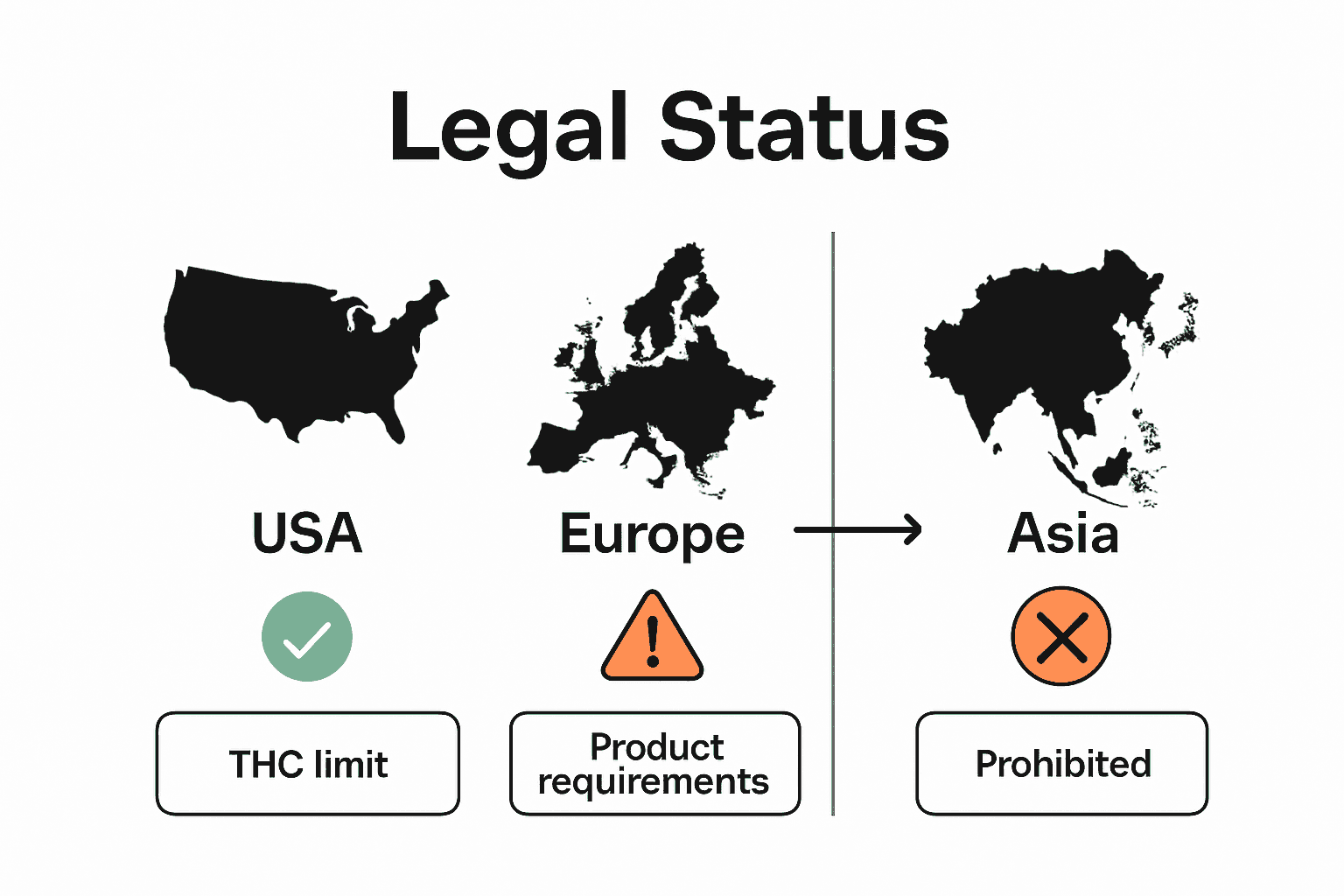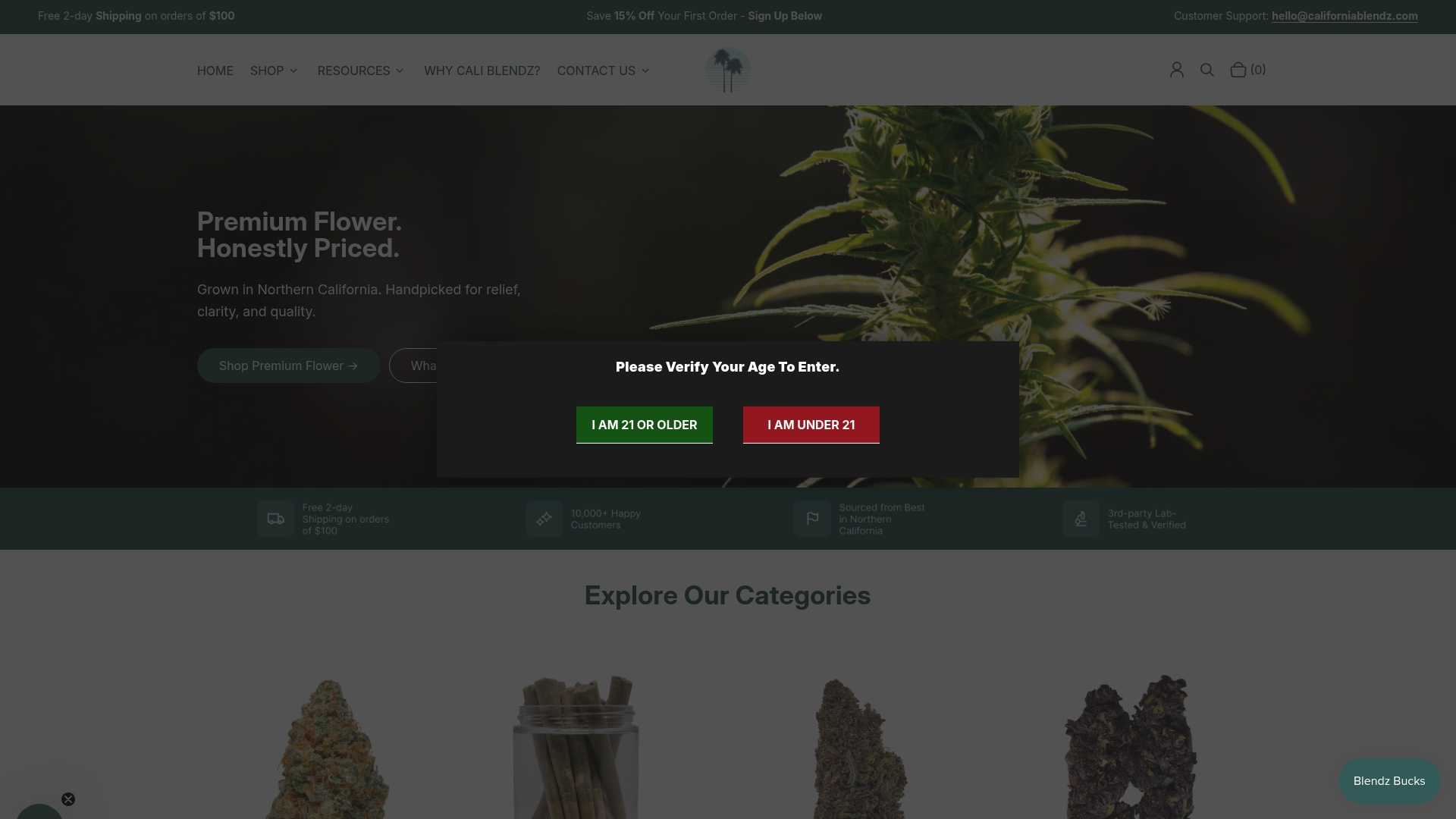CBD Legality in 2025: Complete Guide for Users
Written by Trevor

Nearly eight out of ten Americans are now aware of CBD products, yet confusion about their safety and legality remains widespread. With new laws rapidly changing the status of hemp-derived extracts and a patchwork of global regulations, the world of CBD is anything but simple. Understanding what defines legal CBD, what recent changes mean for consumers, and how to choose compliant products can help you avoid unwanted risks while making informed choices.
Table of Contents
- Defining CBD and Hemp-Derived Products
- Major CBD Legal Changes for 2025
- Regional Differences in CBD Laws Worldwide
- Requirements for CBD Product Compliance
- Risks, Penalties, and Legal Exposure
Key Takeaways
| Point | Details |
|---|---|
| Hemp-Derived CBD Characteristics | Hemp-derived CBD contains less than 0.3% THC, is non-psychoactive, and is available in various forms such as oils, capsules, and edibles. |
| Evolving Legal Landscape | Legal regulations for CBD are changing, especially with proposed alterations to the 2025 Farm Bill, focusing on banning intoxicating products and redefining hemp. |
| Global CBD Regulation Variance | International regulations differ widely, with progressive policies in some European countries and strict prohibitions in others, including Asia. |
| Compliance Requirements | Manufacturers must adhere to strict criteria including THC limits, non-synthetic extraction methods, and thorough lab testing to ensure product safety and transparency. |
Defining CBD and Hemp-Derived Products
Cannabidiol (CBD) represents a fascinating natural compound found in cannabis plants that has captured significant attention in wellness circles. According to the CDC, CBD is a non-intoxicating component extracted from cannabis that does not produce the “high” associated with marijuana consumption.
Hemp-derived CBD specifically refers to extracts sourced from Cannabis sativa plants containing less than 0.3% tetrahydrocannabinol (THC). As Medical News Today explains, hemp plants naturally contain higher CBD concentrations and lower THC levels, making them the primary source for legal CBD products.
Key characteristics of hemp-derived CBD include:
- Extracted from industrial hemp plants
- Contains less than 0.3% THC
- Non-psychoactive chemical compound
- Available in multiple product formats including:
- Oils
- Capsules
- Topical lotions
- Edibles
The legal landscape for CBD continues evolving, with hemp-derived products gaining broader acceptance due to their potential wellness benefits and minimal psychoactive properties. Consumers interested in CBD should always verify product sources, verify third-party lab testing, and understand local regulatory requirements before purchasing.

Major CBD Legal Changes for 2025
The legal landscape for hemp-derived cannabinoids is undergoing significant transformation in 2025. Reuters reports that following the 2018 Farm Bill, entrepreneurs have been exploiting perceived legal loopholes by selling intoxicating hemp-derived cannabinoids like Delta-8 and Delta-10 THC. In response, both federal and state governments are intensifying regulatory crackdowns.
Key legislative developments include proposed changes to the 2025 Farm Bill and FY2026 spending bill, which aim to eliminate intoxicating compounds from hemp products. According to Reuters, the proposed spending bill seeks to redefine hemp and ban products with combined THC levels above 0.3%, potentially outlawing many current hemp-derived products.
State-level regulatory actions are equally significant:
- California, Virginia, and Arkansas have enacted strict hemp product regulations
- Courts have generally upheld state-level restrictions
- Many states are implementing tighter control mechanisms
For cannabis enthusiasts and industry professionals, staying informed about these evolving legal changes is crucial. Understanding Legal Hemp Flower in 2025 provides additional insights into navigating this complex regulatory environment. Consumers and businesses must remain adaptable and vigilant as the legal framework continues to shift.
Regional Differences in CBD Laws Worldwide
Navigating the global CBD legal landscape in 2025 requires a nuanced understanding of varying international regulations. While the United States has been wrestling with federal and state-level complexities, other regions have developed distinctly different approaches to hemp and CBD products.
In Europe, the regulatory environment remains fragmented. Some countries like Switzerland and United Kingdom have relatively progressive CBD policies, allowing sales with strict THC concentration limits. Conversely, countries like France maintain more restrictive frameworks, requiring extensive documentation and limiting CBD product types. Nordic countries typically enforce extremely stringent regulations, often prohibiting most hemp-derived products.
Asia presents an even more complex picture of CBD regulation:
- China maintains strict prohibition on most cannabis-related products
- Japan allows CBD products with 0% THC content
- South Korea permits medical CBD under extremely controlled circumstances
- Thailand has recently emerged as a more progressive Asian market
Legal Status Hemp 2025: Complete Global Guide offers deeper insights into these nuanced international regulations. Consumers and businesses must remain vigilant, as the global CBD regulatory landscape continues to evolve rapidly, with legal interpretations changing frequently across different jurisdictions.

Requirements for CBD Product Compliance
Compliance for CBD products in 2025 demands meticulous attention to multiple regulatory requirements. According to the CDC, most CBD products remain unregulated by the FDA, which means consumers and manufacturers must proactively ensure product safety and transparency.
Key compliance criteria revolve around THC concentration and product origin. As outlined by the University of California Office of the President, CBD does not qualify as legal hemp if it contains more than 0.3% delta-9 THC or if it was synthetically derived. This nuanced definition requires manufacturers to carefully document product composition and extraction methods.
Critical compliance requirements include:
- Maximum 0.3% delta-9 THC concentration
- Natural, non-synthetic extraction methods
- Comprehensive third-party lab testing
- Accurate and transparent product labeling
- Documentation of hemp plant origin
- Thorough tracking of production processes
Understanding Cannabis Labeling Requirements provides additional insights into creating compliant product documentation. Manufacturers must remain vigilant, as regulatory frameworks continue to evolve, demanding ongoing adaptation and commitment to transparency.
Risks, Penalties, and Legal Exposure
Navigating the CBD landscape in 2025 requires a comprehensive understanding of potential legal and health risks. According to the CDC, using CBD products is not without potential complications, with several critical health considerations that consumers must carefully evaluate.
Health risks associated with CBD consumption include potential side effects such as liver damage, drug interactions, drowsiness, diarrhea, appetite changes, and irritability. These medical concerns are compounded by the complex legal environment, where regulatory inconsistencies can create significant legal exposure for both consumers and manufacturers.
Key legal and health risks to consider:
- Potential liver damage from prolonged use
- Possible interactions with prescription medications
- Unpredictable side effects on individual metabolisms
- Risk of unintentional THC consumption
- Potential workplace drug testing complications
- Potential legal penalties for possession in certain jurisdictions
Understanding Cannabis User Privacy Tips provides additional guidance on mitigating personal and professional risks. Consumers must remain proactive, conducting thorough research and consulting healthcare professionals before integrating CBD products into their wellness routines.
Stay Confident and Compliant with Premium Hemp Products in 2025
Navigating the complex landscape of CBD legality can feel overwhelming, especially with evolving regulations around THC levels and hemp-derived cannabinoids. If you want peace of mind and quality assurance, discovering products crafted with transparency and compliance is key. At California Blendz, we understand your concerns about product safety, THC concentration, and sourcing — all critical points highlighted in the 2025 legal updates.

Explore our expertly curated selection in The Founder’s Collection or find precisely lab-tested options in The THCa Prestige Vault. Each product is organically grown and third-party tested to meet strict legal standards, giving you confidence on every purchase. Visit California Blendz today and secure your trusted source for hemp-derived CBD that aligns with the latest legal requirements. Act now to enjoy safe, compliant relaxation without compromise.
Frequently Asked Questions
What is the legal THC limit for hemp-derived CBD products in 2025?
The legal THC limit for hemp-derived CBD products is less than 0.3% delta-9 THC. Products exceeding this limit may not qualify as legal hemp.
How can I verify the compliance of CBD products before use?
To verify compliance, check for comprehensive third-party lab testing results, accurate labeling of THC levels, and documentation regarding the product’s hemp plant origin.
What are the potential health risks associated with CBD use?
Potential health risks of CBD use include liver damage, drug interactions, drowsiness, diarrhea, appetite changes, and irritability. It’s important to consult healthcare professionals before using CBD products.
What are the key requirements for CBD product labeling in 2025?
Key requirements for CBD product labeling include transparency about THC concentration, a clear indication of the product’s hemp origin, and details about extraction methods used to produce the CBD.








